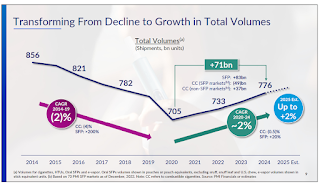Last month Philip Morris International (PMI) talked to investors at the CAGNY conference - an annual event held in Florida to connect manufacturers with investors. PMI used the occasion to report on its experience over the past 10 years on smoke-free products.
This post identifies some take-away facts from this presentation. The slide deck can be viewed here, and the transcript is available courtesy of Seeking Alpha here.
Little more than a decade has passed since PMI became the first multinational tobacco company to re-invent its business and to expand its product line to include new nicotine technologies. It's initial focus was on heated tobacco (IQOS was launched in Italy and Japan in 2014 and introduced to Canada in 2017). In 2022 it began selling vaping products (for which Canada was its first market) and in the same year it acquired Swedish Match and began marketing Zyn pouches.
New nicotine products have allowed PMI's profits to grow
Over the past 10 years, PMI's revenues from cigarette sales have fallen somewhat - from $26.6 billion in 2015 to $23.2 billion in 2024. This loss in revenue has been more than made up for by increased revenues from non-combustible products: from a mere $199 million in 2015 to $14.7 billion in 2024.
Last year the company made 38 cents of every dollar of earnings from "smoke-free" products - heated tobacco, vaping or pouches. (slide 37)
New products have allowed PMI to sell more nicotine.
Overo the past 10 years, the number of cigarettes sold by Philip Morris have fallen steadily (because they increased prices, the drop in revenues was not as acute). This loss in volume sales has been largely made up for by an increase in the number of other nicotine products sold. Using "stick equivalent units" to compare sales with traditional cigarettes, the company reports that after 2020 newer product sales allowed them to turn an annual 2% decrease in units of nicotine sole to a 2% annual increase. (Slide 9)
New Nicotine Products are more profitable than traditional cigarettes.
It costs PMI much less to manufacture cigarettes than IQOS (at a global level, an average of $13 per 1,000 cigarettes vs. $26 per 1,000 IQOS devices and sticks), but they nonetheless make much more money from IQOS sales ($54 for 1,000 IQOS vs $23 for cigarettes).
For Zyn, the profit difference is even more dramatic. In the United States, the company makes $185 on 1000 Zyn pouches, which costs them $30 to manufacture. (Slide 16).
The global nicotine market is not shrinking as alternative product sales grow.
As the world observes the 20th anniversary of the Framework Convention on Tobacco Control it is disheartening to hear that PMI estimates that global nicotine sales (86% of which are cigarettes) are not falling and that the "Total nicotine market [is] close to stable". (slide 24)
Ignoring other tobacco products (like bidis, hookah, etc), the company estimates that the for every 6 cigarettes sold world wide, there is one equivalent dose of nicotine sold in the form of heated tobacco, vaping liquids or nicotine pouch.
The proportion of the nicotine market taken up by traditional cigarettes varies greatly by country. PMI presented separate data only for the United States, where slightly less than half of nicotine products sold are cigarettes. (Slide 25)
Smokers who also use vaping or pouches use nicotine more often than those who only smoke or vape.
PMI reported the results of its consumer research into the volume of use by individuals who use one or more product category. They found that those who used more than two non-combustible products (HNB, vaping and oral) "have substantial higher daily consumption" than do those who use only one product.
Those who use both cigarettes and non-combustible nicotine also increase the volume of product they use. Individuals who use only heated tobacco use about the same quantity of product as do smokers, but those who only vape use less. (Slide 28)
In his comments, PMI CEO Jacek Olczak alluded to the role that these products have in overcoming regulatory and social restrictions on smoking. "...We start looking into the nicotine, new nicotine market, the smoke-free market more from the multi-category perspective versus the one because we also see this in the marketplace, then the consumers are not really focused on one product category. They're looking at the smoke-free products from the perspective of the repertoire which satisfies or responds to the different needs or moments or situations they might have during the day."
PMI's new products appeal more to wealthier people.
Included in this investor presentation was information on the age and income brackets of individuals who used PMI's brands of cigarettes, heated tobacco, vaping and nicotine pouches. Globally, most of their customers are in middle or higher income brackets, and this is even more true for the non-cigarette categories. Its vaping products are more likely to be purchased by younger people.







